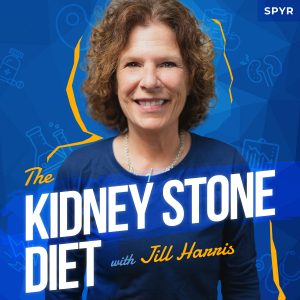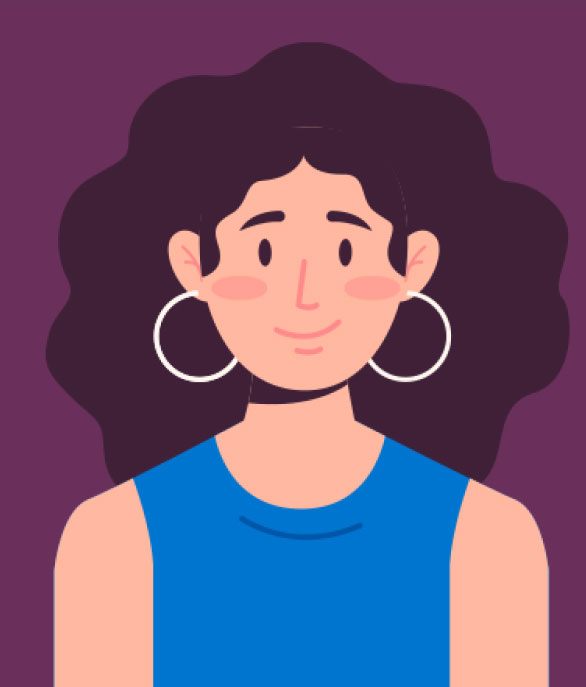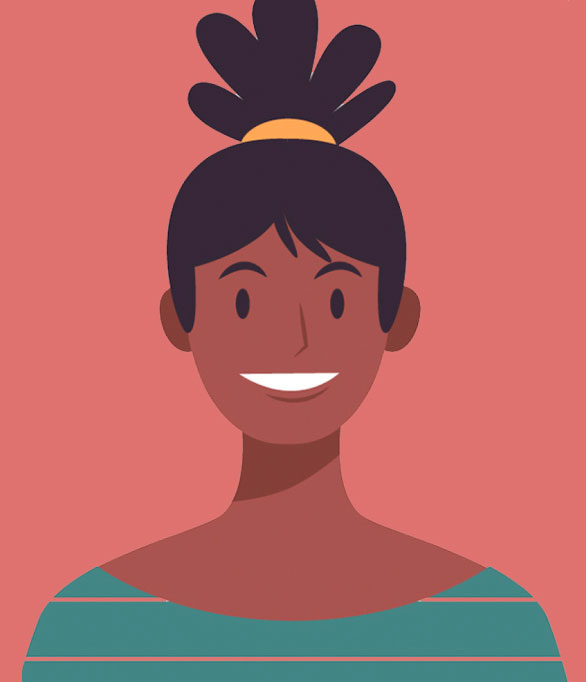This week Jill answers a listener question about fiber, constipation, and why foods high in sodium are low in oxalate.
Jeff Sarris: Welcome back to the Kidney Stone Diet podcast, the show about reducing your kidney stone risk and living your best life. I’m your host and fellow student, Jeff Sarris.
Jill Harris: I’m so happy to be here! I’m Jill Harris, your kidney stone prevention nurse.
Jeff Sarris: I love when we get a little musical interlude at the beginning. It’s perfect!
Jill Harris: Sometimes, I just get a burst of energy and happiness and I need to let it out. I don’t want to keep that in.
Jeff Sarris: Yeah, for sure! And now it’s been a little bit that you’re in a new place, how’s it been going?
Jill Harris: You know, I really like it. So all that stress, right? We all get so stressed in our lives about stuff, you know, the stuff that’s about to happen, “how am I going to get all the stuff done?!” And then you get it done and you’re like “oh, that wasn’t so bad.” And you’re so happy in the new space. I had a friend that said, “Jill, be happy wherever you go. You just need to calm the heck down.” And I knew that that was true, but I’ve really reflected on that ever since that was told to me and it’s so true. I’m very happy with my new neighborhood. I’m close to my son’s school. He actually walked home from school yesterday and I’m so happy about that. The neighborhood is safer, overall.
I love my neighbors. It’s a three flat, so they’re like 14. Not really, but yeah, so they call me grandma Jill. “Grandma Jill, you got a strainer?” “Yes, honey. Come on down and get it.” “Grandma Jill, what are you baking?” “Oh come on down and have some.” So, it’s really nice. It feels very tiny and like a community – everything that I love. And coming from that big old high rise which I love seeing people all the time I mean it’s just feels tighter and closer, you know. I like community, so it makes me very happy to be here and I’m telling you Jeff, it honestly feels like living smack dab in the middle of New York because there isn’t anything I can’t walk to. And for me who loves walking so much forget about it, baby!
Jeff Sarris: And actually Saturday we’ll be in your neck of the woods, so we may have to at least swing by and just say hi if you’re around.
Jill Harris: Yes, please stop by! What are you going to do, or maybe you don’t want to say in the podcast?
Jeff Sarris: Oh no, it’s all good! We’re going to a little museum that’s right up there by you, so it’s like right down the street from the park itself. So yeah, I’ll definitely text you and maybe swing by. But yeah, anyway I guess we could get into kidney stones for this week.
Jill Harris: All right, let’s do it. Oh, and I will say Luke has actually lost a couple pounds. He’s so happy walking, too. I bring him down the block so when we’re getting ready I’m like “dude, I have calls. We got to go!” He sits down and he’s, you know, 95 pounds so it’s like –
Jeff Sarris: Oh no!
Jill Harris: It’s so adorable. He loves it, too, so I’m very happy with all of it. Anyway, thanks for asking.
Jeff Sarris: It’s a lot easier to get out, too, I’m sure just because like you were up – how many floors up were you?
Jill Harris: Twenty-nine. 29 floors so now I’m right here on the first floor. I feel like I’m in a house, right? The porch is right there, so it’s wonderful. It’s wonderful. He sits on the porch. He thinks he owns the neighborhood. He’s like an old Italian Nana, with his own Italian Nana owner and we sit on the porch watching the neighborhood, what’s going on, what’s shakin? We have a ball!
Jeff Sarris: I love it! That’s great. All the stress, like you said, it’s stressful, but it always works out. Everything comes together and you find your joy in it.
Jill Harris: Jeff, here’s the deal, and this is why I love talking to patients. I’m like listen, listen, Cynthia. Listen, listen Frank. Listen to all of this. Change is hard! Of course you’re gonna be overwhelmed with all these dietary changes. You were just thrown five lists. You don’t know what the hell to do with this, right? And now you’ve gotta lower water. Well, what does that mean? Increase the calcium. How do you do it? You’re a vegan. What you’re gonna do now? I mean, it’s very complicated when you’ve been thrown changes. I’m just talking about a move.
Forget about it when you’ve been sick and now a doctor or nurse is telling you you got to do this. It’s very overwhelming, so change for for us as human beings is difficult for each and every single one of us. It’s just overwhelming. We’re creatures of habit, right? So our job here, Jeff, is to teach people new habits. How do we teach people new habits? It takes a minute. Ain’t gonna happen overnight. And then once you get them under toe, every single patient I’ve ever worked with is like, “eh, I’ve got it now, girl.” So you practice it just like anything else in life. What do you think about that?
Jeff Sarris: Oh, yeah, it becomes part of your lifestyle. That’s the thing and then it’s just a new version of you, is really what it is. But that’s why habits are just difficult because it’s so ingrained, like who we are. Like you mentioned eating oatmeal every day for 40 to 50 years kind of thing and it’s hard to get out of a system like that. It all takes time.
Jill Harris: Well, our habits are easy. We don’t have to think about them. And I’m always pushing my patients – and the patients who know me, they’re like, oh, here she goes, she gonna say that, but I am going to say it – I don’t know why or how we’re not thinking about the type of food we’re putting in our mouth, the amount of food we’re putting in our mouth. I don’t know how we’re not spending a little bit more time thinking about how we’re going to nourish this machine of ours. You know, I just, I don’t get that. And so I get it at first when I first bring this topic up people are like “oh, yeah, I guess I should think about that.” But then after a year, six months to a year, you really should, right?
Jeff Sarris: Yeah, definitely. So, should we dive into the question of the week? This is from Susan Kara.
Listener Voicemail: My name is Susan Kara, and I’m from the Bronx, New York, and I suffer from calcium oxalate stones. My question for Jill is that I noticed on the list of foods that there are foods on that list that I don’t understand how they could be low. Like I noticed that bacon two slices, bologna, a can of chicken noodle soup, I would think that that’s full of sodium. I know it’s full, you know, it has a lot of sodium. So like, how is that on the low oxalate side? I don’t really understand. I’m getting very confused with the food lists and that’s one of the problems. I’m trying so hard to get it right and I was kind of confused with that.
My other question was I also suffer from IBS, and I need to take Miralax. I was told that if you have a kidney stone problem – I read an article and I don’t know if this is true or not – but it said that Miralax is not good to take if you have kidney stones. So, I’m really concerned about that because I really need that. I’m noticing that a lot of foods with fiber are high in oxalate. I’m like really messed up with finding like, how to eat properly. I’m trying so hard. So, those were my two questions. I’m hoping that I can at least get some kind of answers so that I can at least know how to how to eat and understand the list. So, thank you. Thank you for allowing me to ask these questions. Have a great day.
IBS, Miralax, and Fiber on a Low Oxalate Diet
Jill Harris: Oh my gosh, she just made my heart smile. So it don’t matter that I’ve done this 500 years, it doesn’t matter. Every time I hear that or I hear somebody kidney stone journey, it’s like I just started this job. That’s how much my heart feels, truly. So this is for Susan from the Bronx, baby! Susan from the Bronx! So, there’s two questions here we’re going to touch on. I’m already thinking how the hell is Jeff going to title this YouTube one because it really is two really separate questions. We’re talking about how we all need fiber. She has IBS. She needs fiber. Okay. And because she’s talking about Miralax and fiber, she probably has IBS-C, which she’s more constipated. Susan’s like “really did you have to?” Yeah, Susan, we’re talking about it because we talk about everything here. Why wouldn’t we? Being constipated is terrible.
When I was going through all my chemo and everything, and having to deal with rectal cancer, you’re either going too much or you ain’t going at all. And so being constipated is terrible. And so many people are because we don’t get enough fiber in our diets. Now, and I’ll get to her first thing, I understand what she’s asking with the sodium and the oxalate. This is mostly going to be oxalate-focused, okay? And I want to really focus on fiber and oxalate. When people are thrown that list or they’re looking at my Harvard list on my website at kidneystonediet.com. On kidneystonediet.com, I have a free oxalate, list. Go get it! So, when people are put on a low-oxalate diet, they immediately think that well, no more fruits and vegetables for me. No more for me. And so what happens is, they now have lowered their fiber.
We need between 25 and 35 grams of fiber a day. The average American is getting 12. That ain’t enough for a healthy bowel, said the rectal cancer patient who’s in remission. The thing that has always has been so ironic is I’ve always been a proponent of fiber. So you’re going to get that mainly from fruits and vegetables, of course, and some whole grain carbs. But people really limit these three things on a low oxalate diet. And Susan from the Bronx, I’m here to tell you, you don’t have to. And the other thing, real quick, Miralax is not going to bother kidney stones, but I’d rather you get your fiber from fruits and vegetables and whole grains. “Whole grains are high in oxalate, Jill!” “I can’t have no fruit, Jill, it’s high in oxalate.” You can’t have raspberries, that’s it. “Kiwis, they’re high, Jill!” I eat ’em. I even eat them with the skin on as I’m known around town to do.
So you can have them. Here, Susan, this is going to help you. Unless the doctor has told you, otherwise, you all get 100 grams milligrams of oxalate a day. Use the Harvard list on my website, at kidneystonediet.com that we give away free. Along with that food list, we give the safe list. So, because I’m so used to patients saying to me, I ain’t got nothing to eat, I took the Harvard list, and we made it into just the safe list. We took away the really high things. Now you can eat everything on this list. “Well, Jill, still some of these things on this list are 50 something or others of oxalate in a portion size?” Well, that doesn’t mean you can never have it. It means you have 100 milligrams a day unless the doctors told you otherwise. Have 50 something of something. Have it! That’s where you’re going to put a glass of non-dairy or dairy milk, okay?
So, it’s not like you can’t have higher oxalate products. What about spinach? No, it’s almost 700 milligrams a cup. No! Stop asking me about spinach! You can’t have it! That’s it. I don’t take away much else. Just a couple things, like buckwheat groats, whatever, and raspberries because who wants one of those? Okay, now, you could say well, if you’re saying I can have all these higher ones, I’ll just have two raspberries and put them in yogurt. You can do that. If that’s how you want to spend your oxalate bucks.
I give you your control back. Instead of saying no to all these foods, you get the Harvard list. Use it and look at the portion size and how much oxalate is in that portion size. Right now I’m giving you a debit card. It has 100 milligrams of oxalate in it. Use your Harvard list by the portion size and start debiting your account. When you get close to 100, you’re done. That means you get some choices back in your life. You get to eat food you like again. You just can’t eat it every day in whatever amount you want. That’s why people get into trouble.
Spinach and almonds with absolutely no calcium in their diet. That is what leads to stones very often. Not for everyone, but very often that is what is repeated over and over again. So Susan from the Bronx you can definitely increase your fiber naturally by incorporating more fruits and vegetables into your diet you really can. An apple, four grams of fiber right there. A pear, eight grams of fiber right there, if you can tolerate those things. Also, on kidneystonediet.com, because this is such a common thing, we have a list of lower oxalate foods with higher fiber amounts. Go to my website at kidneystonediet.com– I believe that’s in the blog. Do you know, Jeff?
Jeff Sarris: I don’t remember, but it should be in the blog.
The difference between oxalate and sodium
Jill Harris: I think it’s in the blog section. Dave, who’s our other partner, made a nice, beautiful infographic, so look for it at kidneystonediet.com. It is an oxalate fiber comparison list. Foods you can safely eat for lower oxalate and getting your fiber. That’s a really, really great infographic. I’m very happy with that one. What else, Jeff? Oh, she asked the salt and the oxalate thing. Okay. So, Susan, when you see the big list, specifically on my website, the oxalate food list is saying what’s high in oxalate. What’s high in oxalate or low in oxalate doesn’t mean it’s low or high in salt. So, these are things you have to figure out by yourself, meaning if you’re going to focus on oxalate, go on the list and say, “Okay, this product is lower in oxalate, so I can have it.” But that don’t mean it’s low in salt.
People will say what the heck? Harvard studied food and they’re telling us to eat, like some unhealthy food like apple pie. It don’t got no oxalate! So what does that mean? We can eat it? No, that just means they studied it and it doesn’t have a lot of oxalate. People, don’t quote me on that. It came out of my head. That doesn’t mean number one, it’s healthy. It just means they studied it for oxalate value. And it doesn’t mean it’s low in salt. It doesn’t mean it fits any other component of the Kidney Stone Diet. I hope that’s clear. And so, of course, that’s a separate list telling people telling patients what the oxalate levels of certain food foods are. It has nothing to do with their sodium. So, right, Susan from the Bronx, bologna, no oxalate, but holy brusho high in sodium! So that’s not something you want to eat. Do they still make Bologna? I don’t even know. And I ate a lot of Bologna as a kid, bologna and mayonnaise. I used to love bologna. Do they still make it?
Jeff Sarris: Oh, yeah, for sure. Yeah, it’s one of those classic things, but I haven’t had it in so long!
Jill Harris: I used to love it.
Jeff Sarris: Uh huh, me too!
Jill Harris: So, Susan from the Bronx, you’re just getting confused. That’s a separate thing, just for oxalate. You always need to look at packages for how much sodium is in something. That’s how you find out how much sodium is in something. So, when you’re first starting the Kidney Stone Diet, you’re juggling a few things, but be patient. Read or listen to our podcast on Spotify and listen to this YouTube channel. We give away so much free information, so that you’re less overwhelmed. And on kidneystonediet.com there’s a start page, kidneystonediet.com/start. And I know everyone’s like, boy, how many times can you say your website? But I’m saying it because it’s all the free stuff there! So go there for the free stuff, okay? We know it’s overwhelming, so we created just a start page so you can get where you need to be at the beginning, okay?
Jeff Sarris: So I found on the site, it’s called “Your high fiber, low oxalate grocery list.” So that’s the post you want to look for that combines all of that together, like exactly what you were saying. But yeah, I wanted to track down exactly where it was because we should add that, put it with the oxalate lists, maybe in the resources section, too, because it is super important, super valuable, and something that we haven’t really touched on. Like we touch on oxalate on this show all the time, but that connection between fiber and oxalate, this is, I think the first time that we’ve gotten there.
Jill Harris: It’s a big deal. When patients are incorporating the Kidney Stone Diet changes, there’s a few things they do. They start adding calcium back. If you’re able to tolerate dairy products, you may start feeling a little constipated. Put that with now you ain’t eating no fruits and vegetables because you’re petrified of oxalate and you have a very constipated patient on your hands. And like I said, I never dealt with that until I went through all my cancer stuff, it’s so uncomfortable. I have a new appreciation for people who have chronic constipation. Obviously, it’s not good to not get rid of the waste in your body, but it is super uncomfortable. So uncomfortable. I can’t stress that enough, so my heart goes out for patients that experience that.
So remember, 25 to 35 grams a day for fiber. When we’re incorporating fiber, paying attention to it more, we need to do a couple of things. You can’t go from eating no fiber to 35 grams of fiber, you will be sick. Your stomach will hurt. You’ll lose loved ones because your stomach will never be the same. You’ve got to slowly adapt. “So what does that mean, Jill, slowly adapt?” I would add so if you’re getting the average 12 grams of fiber a day – “how do I know if I am, Jill?” Turn it around, Buster Brown and look at your nutrition labels. It will list the fiber. So start adding how much you get on just a regular day. Maybe you only get five grams of fiber, whatever it is. “Apples don’t have no nutrition label, Jill!” It’s called Google, people! It’s been around for a minute. Google it. Okay, it has about four grams of fiber.
So when you don’t know because there’s no label – first of all, it’s gonna be a healthier food because it’s in the produce section, there’s gonna be a little bit of fiber in there – Google it and it will tell you. And so when you’re incorporating more fiber, if you’re getting 12 a day, I would maybe strive the next week, go to 15. The next week after that, try for 20. If you’re like “ay! Twenty’s doing me right now, or 15, I need to stay here for a minute,” then you stay there for a minute. Listen to your body, please. Your body will tell you everything you need to know. And when you make lifestyle changes, you get a new perspective, you’ll start thinking, “Oh my God, that’s salty. Who would have ever thought I noticed something that was salty, right?”
So as you adapt and get a new perspective for the new, healthier foods, and normal portion sizes that you’re putting in your body, you will notice changes, and most of them are very, very good, okay? I have a lot of healthy patients, happy patients, because they’re making these changes. The other thing while you’re incorporating fiber is please make sure you’re getting enough fluids. The only way to get all the things that the fiber is doing, like bulking up your stool and creating more stool is to, you know, get rid of the stool. So you need to drink your fluids to help flush that new, happy, fluffy stool out of you, okay? So that’s important, too. You have to drink fluids when you’re upping your fiber. It will help get rid of it, okay? I love talking about fiber.
Jeff Sarris: Yeah, I think that was great. I mean, I do think this is one of those areas we just didn’t get to so far. Thank you so much, Susan, for that question. And for anyone else out there who has a question of their own, that number again is 773-789-8763. And Jill will answer your question on a future episode. We really appreciate everyone who calls in, takes the time out of their day to leave the message, and the people who are taking their time to watch, listen to the podcast and leave a comment and like and subscribe. Like, it really goes a long way, especially on YouTube, for helping us reach more people because that’s the only reason we’re doing this. I mean, this is completely free, one of the many free things like all the things on the website as well, that we just want to reach as many people as we can and make a difference in any way that we can along the way.
Jill Harris: Look, I think it’s really important and Jeff thinks it’s really important, I have paid services. Not everybody can afford paid services and so we recognize that. Since we’re talking about your health, and we’re talking about a chronic condition that is lacking in the medical field, we take it upon ourselves to make sure that we are giving as much as we’re receiving here and so we want to make sure that we always give back to the audience. The comments go a long way. Help each other in the comments. Are you constipated? Have you been constipated? Can you help Susan with some tricks that you’ve learned? I will say one more thing if I were writing a comment I would say movement is really important. You want to move your bowels, you’ve got to move your body. I’m going to make a new t shirt out of that one you want to move your bowels you got to move your body. You can’t be sitting around watching Netflix and eating apple pie and not moving you got to move, too. The body wants to move so it can move everything within it. All right, Jeff, I’m done.
Jeff Sarris: No, this is really good! The movement is such a key piece of it. So yeah, we have some new merch on the way then I guess. We do have so many ideas for different things just little inspirational things like little merch you already have like the apparel and whatnot. But yeah, when we get around to it, there’s going to be a few more things that could be really fun.
Jill Harris: People are saying they want aprons that say “Just a bit” or “Turn it around, Buster Brown.” We’ve gotta get that!
Jeff Sarris: Yeah, for sure! For everyone listening, thanks again. We appreciate you taking your time and we will see you next week.
Jill Harris: Bye, everybody! Thank you, Susan from the Bronx!














Leave a Reply